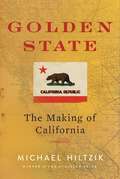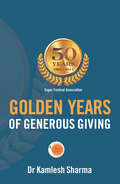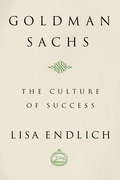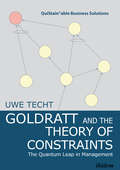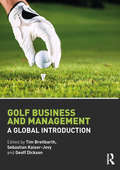- Table View
- List View
Golden Rule: The Investment Theory of Party Competition and the Logic of Money-Driven Political Systems (American Politics And Political Economy Ser.)
by Thomas Ferguson"To discover who rules, follow the gold." This is the argument of Golden Rule, a provocative, pungent history of modern American politics. Although the role big money plays in defining political outcomes has long been obvious to ordinary Americans, most pundits and scholars have virtually dismissed this assumption. Even in light of skyrocketing campaign costs, the belief that major financial interests primarily determine who parties nominate and where they stand on the issues—that, in effect, Democrats and Republicans are merely the left and right wings of the "Property Party"—has been ignored by most political scientists. Offering evidence ranging from the nineteenth century to the 1994 mid-term elections, Golden Rule shows that voters are "right on the money." Thomas Ferguson breaks completely with traditional voter centered accounts of party politics. In its place he outlines an "investment approach," in which powerful investors, not unorganized voters, dominate campaigns and elections. Because businesses "invest" in political parties and their candidates, changes in industrial structures—between large firms and sectors—can alter the agenda of party politics and the shape of public policy.Golden Rule presents revised versions of widely read essays in which Ferguson advanced and tested his theory, including his seminal study of the role played by capital intensive multinationals and international financiers in the New Deal. The chapter "Studies in Money Driven Politics" brings this aspect of American politics into better focus, along with other studies of Federal Reserve policy making and campaign finance in the 1936 election. Ferguson analyzes how a changing world economy and other social developments broke up the New Deal system in our own time, through careful studies of the 1988 and 1992 elections. The essay on 1992 contains an extended analysis of the emergence of the Clinton coalition and Ross Perot's dramatic independent insurgency. A postscript on the 1994 elections demonstrates the controlling impact of money on several key campaigns. This controversial work by a theorist of money and politics in the U.S. relates to issues in campaign finance reform, PACs, policymaking, public financing, and how today's elections work.
Golden State: The Making of California
by Michael Hiltzik“Superb. Hiltzik makes a compelling case that California is the heartbeat of our nation.”—Douglas Brinkley, New York Times bestselling author of Silent Spring RevolutionFrom Pulitzer Prize winner Michael Hiltzik, a definitive new history of California—from the Spanish conquistadors to the Gold Rush to the state’s meteoric rise as a tech powerhouse and bulwark of progressivism—and of its indelible mark on the United States and the world.California has long reigned as the land of plenty, a place where the sun always shines and opportunity beckons. Even prior to its statehood in 1850, it captured the world’s imagination. We think of bearded prospectors lured by the promise of gold; we imagine its early embrace of immigrant labor during the railroad boom as prologue to its diverse social fabric today. But what lies underneath the myth is far more complicated.Thanks to extensive research by Michael Hiltzik, one of our longstanding voices on California, Golden State uncovers the unvarnished truth about the state we think we know well. From Spanish incursions into what became known as Alta California to the rise of Big Tech, the history of California is one of stark contradictions. In rich, previously overlooked detail, we see its earliest statesmen wreak havoc among native peoples while racing to draft their own constitution even ahead of statehood. Gold-hungry settlers venture into the Sierra foothills only to leave with little, while a handful of their suppliers turn themselves into millionaire railroad magnates. Wars erupt in the name of water as Los Angeles booms, and early efforts to tame the vast landscape create a haven for fossil fuel extraction and environmental conservation alike. Hollywood politicians stoke fear, contributing to a centuries-long tradition of anti-Asian violence, and, remarkably, legal redlining and free higher education take root together.Golden State brings a fresh critical eye to the origins of the state against which the rest of the country measures itself. From its very start, Hiltzik shows, the story of the United States was written in California.
Golden Years of Generous Giving: Sugar Festival Association – Lautoka - Fiji
by Dr Kamlesh SharmaThe Sugar Festival Association is incorporated under the Charitable Trusts Act (Cap 67) of Fiji. Its main aim is to raise funds for charitable purposes by organising the annual Sugar Festival and undertake projects that benefit the community as a whole. The Lautoka Sugar Festival is one of the largest in Fiji and its origin goes back to early 1961 when the first Festival was organised by the Lautoka Junior Chamber of Commerce (Lautoka Jaycees). The Festival continued as an annual event under the stewardship of Lautoka Jaycees until 1980 when it was announced that the running of the Festival would be handed over to a public committee. This resulted in the establishment of the Sugar Festival Association that is now responsible for organising the annual Festival on the foundation of generous goodwill and commitment of its volunteers and supporters.
Golden: The Power of Silence in a World of Noise
by Leigh Marz Justin ZornSilence isn’t just the absence of noise. It’s a presence that brings us energy, clarity, and deeper connection.Justin Zorn and Leigh Marz take us on an unlikely journey—from the West Wing of the White House to San Quentin’s death row; from Ivy League brain research laboratories to underground psychedelic circles; from the temperate rainforests of Olympic National Park to the main stage at a heavy metal festival—to explore the meaning of silence and the art of finding it in any situation.Golden reveals how to go beyond the ordinary rules and tools of mindfulness. It’s a field guide for navigating the noise of the modern world—not just the noise in our ears but also on our screens and in our heads. Drawing on lessons from neuroscience, business, spirituality, politics, and the arts, Marz and Zorn explore why auditory, informational, and internal silence is essential for physical health, mental clarity, ecological sustainability, and vibrant community.With vital lessons for individuals, families, workplaces, and whole societies, Golden is an engaging and unexpected rethinking of the meaning of quiet. Marz and Zorn make the bold and convincing argument that we can repair our world by reclaiming the presence of silence in our lives.
Goldene Regeln für das Talent Management: Worauf Unternehmen achten sollten, um erfolgskritische Positionen zu besetzen (essentials)
by Klaus P. StulleKlaus P. Stulle vereint in diesem essential zwei Herangehensweisen an ein sehr zeitgemäßes Thema: Zum einen beschreibt er entlang konkreter Ergebnisse ein Instrument, mit dem der Reifegrad des Talent Managements im Unternehmen erfasst werden kann. Im zweiten Teil werden als getrennte Checkpoints zehn goldene Regeln vorgestellt, mit denen das vorhandene Talent Management dann weiter optimiert werden kann. Insofern finden Praktiker sowohl in Großunternehmen und Konzernen, aber auch im Mittelstand ganz konkrete Hinweise, mit denen die jeweilige Unternehmensrealität hinterfragt und vorangebracht werden kann.
Goldfinger: Charles W. Engelhard Jr. and Apartheid-era South Africa
by Geoffrey G. Jones Elliot R. BentonThis case considers the strategies of Charles W. Engelhard, an American mining magnate who made large investments in apartheid-era South Africa. Engelhard was widely believed to have been the model for the James Bond villan Auric Goldfinger. During the 1950s and 1960s Engelhard, who was well-connected with the leadership of the Democratic Party in the United States including President Lyndon B. Johnson, was one of the largest American investors in that country. His close relationship with Harry Oppenheimer, the head of the Anglo-American Corporation, gave him substantial influence within the South African business system. The case starts with anti-apartheid demonstrators protesting outside a ceremony awarding him a prize in Newark, New Jersey. It provides an opportunity to debate the political and ethical responsibilities of businesses in repressive regimes, and the challenges faced by entrepreneurs operating in countries with different value systems and political regimes.
Goldman Sachs
by Lisa J. EndlichThe history, mystique, and remarkable success of Goldman Sachs, the world's premier investment bank, are examined in unprecedented depth in this fascinating and authoritative study. Former Goldman Sachs Vice President Lisa Endlich draws on an insider's knowledge and access to all levels of management to bring to life this unique company that has long mystified financial players and pundits.The firm's spectacular ascent is traced in the context of its tenacious grip on its core values. Endlich shows how close client contact, teamwork, focus on long-term profitability rather than short-term opportunism, and the ability to recruit consistently some of the most talented people on Wall Street helped the firm generate a phenomenal $3 billion in pretax profits in 1997. And she describes in detail the monumental events of 1998 that shook Goldman Sachs and the financial world.Her book documents some of the most stunning accomplishments in modern American finance, as told through the careers of the gifted and insightful men who have led Goldman Sachs. It begins with Marcus Goldman, a German immigrant who in 1869 founded the firm in a lower Manhattan basement. After the turn of the century, we see his son Henry and his son-in-law Sam Sachs develop a full-service bank. Sidney Weinberg, a kid from the streets, was initially hired as an assistant porter and became senior partner in 1930. We watch him as he steers the firm through the aftermath of the Crash and raises the Goldman Sachs name to national prominence. When he leaves in 1969 the firm has a solid-gold reputation and a first-class list of clients. We see his successor, Gus Levy, a trading wizard and in his day the best-known man on Wall Street, urging greater risk, inventing block trading (which revolutionized the exchanges), and psychologically preparing Goldman Sachs for the complex and perilous financial world that was the 1980s.Endlich shows us how co-CEOs John Whitehead and John Weinberg turned the family firm into a highly professional international organization with a culture that was the envy of Wall Street. She shows as well how Steve Friedman and Robert Rubin brought the firm to the pinnacle of investment banking, increased annual profits from $900 million to $2.7 billion, and achieved dominance in most of the businesses in which the firm competes internationally. We see how Goldman Sachs weathered both an insider trading scandal and the fallout from its relationship with Robert Maxwell.We are taken to the present day, as Jon Corzine and Hank Paulson lead the firm out of turmoil to face the most important decision ever placed before the partnership--the question of a public sale. For many years the leadership wrestled with the issue behind closed doors. Now, against the backdrop of unforeseen events, we witness the passionate debate that engulfed the entire partnership. A rare and revealing look inside a great institution--the last private partnership on Wall Street--and inside the financial world at its highest levels.
Goldman Sachs IPO (A)
by Boris Groysberg Ashish Nanda Malcolm S. Salter Sarah G. MatthewsAddresses the proposed IPO and raises questions regarding how agency costs may rise or fall as Goldman converts from a private partnership to a public limited corporation.
Goldman Sachs: Anchoring Standards after the Financial Crisis
by Rajiv Lal Lisa MazzantiGoldman Sachs, a longtime venerable financial institution headquartered in New York City, had a partnership culture that was known to value its clients. But when the financial crisis hit in 2008 and Goldman Sachs emerged relatively unscathed, its public image took a large blow as people questioned the inner workings of the bank. To address the situation, Goldman Sachs CEO Lloyd Blankfein called for the creation of the Business Standards Committee (BSC) to carry out a rigorous introspection of the firm. This case explores the reactions of the executives at the bank over the short- and medium-term to public accusations and scrutiny and whether the implemented solutions devised by the BSC are sustainable. It details the themes of individual and collective accountability, reputational awareness, and client care.
Goldman Sachs: Making an Imprint in Impact Investing
by Shawn Cole Vikram Gandhi Lynn Schenk Caitlin Lindsay Reimers BrummeGoldman Sachs acquired Imprint Capital Advisors, a small firm that specialized in advising clients on environmental/social/governance (ESG) and impact investments. The founders sold Imprint with the belief that joining a global financial firm would help to scale impact investing, if not bring it into the mainstream. The case is set two years after the acquisition. It describes impact investing, the founding of Imprint, and its evolution from serving foundations and home offices to financial institutions, and its sale to and integration within Goldman Sachs. The founders consider the past two years and whether the acquisition has, in fact, help to scale ESG/impact investing.
Goldman Sachs: The 10,000 Small Businesses Program
by Leonard A. Schlesinger Aldo SesiaThe case takes students through the creation and evolution of Goldman Sachs 10,000 Small Businesses Program - a public and private partnership to provide education, a network of support and capital to small businesses across the U.S.
Goldman Sachs: The 10,000 Women Initiative
by Christopher Marquis Catherine Ross V. Kasturi RanganGoldman Sachs' five-year, $100 million philanthropic initiative to provide practical business and management education to 10,000 women around the globe recently celebrated its first anniversary and over 1,200 women were either enrolled in, or graduated from sponsored certificate programs. The case describes the conception, development and implementation of the initiative and outlines some key strategic decisions facing the firm as they roll-out the program over the coming years. These include: how to organize the network of schools that deliver the educational services, how to determine the best outside partners to provide additional services for the women entrepreneurs, how to best assess the impact of the program, and finally the extent to which the initiative provides contributions to the long-term strategy of the firm.
Goldman Sachs’ Digital Journey
by Sunil Gupta Sara SimondsGoldman Sachs' Digital Journey by Sunil Gupta and Sara Simonds
Goldman, Sachs & Co.: Nikkei Put Warrants--1989
by Peter TufanoJapanese financial institutions' willingness to sell put options on the Nikkei Stock Average provides investment banks with the raw material from which to create a security that would allow U.S. investors to bet on falls in the Japanese Stock Market. The investment bank that seeks to create this new product must decide how to design, produce (hedge), and price the options (Nikkei Put Warrants). Highlights the global nature of new product development in the securities market and provides opportunities for students to make and critique the key decisions involved in creating this new product. Students must consider the costs of production, the preferences of consumers, competitive dynamics, and the pricing of substitutes for the new product.
Goldratt and the Theory of Constraints: The Quantum Leap in Management (QuiStainable Business Solutions #4)
by Uwe TechtThis book uses engaging language and real-life examples to provide an overview of the methods and tools of the theory of constraints: drum-buffer-rope, buffer management, throughput accounting, pull distribution, irresistible offer, corporate strategy, and viable vision. It explains how to recognize and use constraints, complete projects quickly and reliably, and gain a competitive lead and turn it into profit.
Golf Business and Management: A Global Introduction
by Tim Breitbarth, Sebastian Kaiser-Jovy and Geoff DicksonGolf is big business around the world. With high profile series such as the PGA, LPGA and European tours to the re-introduction of golf to the Olympics at Rio 2016, golf occupies a prominent place in the global sport community. This is the first book to introduce the fundamentals of golf business and management from a truly international perspective, covering key topics such as media, club management, sponsorship and retail, at elite and non-elite levels. With sections exploring the development of golf on every continent, including North America, South America, Europe, the Middle East, Africa and Asia, this book presents the latest thinking on current issues in golf, ranging from sustainability and innovation to global governance. Each chapter incorporates helpful features for students including learning objectives, discussion questions, guides to further reading, recommended websites and insights from industry voices. This book is essential reading for students of any golf-related degree course or professional accreditation programme, and will also be of interest to those studying or working in sport business, sport management and sport tourism. Underpinned by up-to-date literature, golf researchers will also find the book a useful starting point.
GolfLogix: Measuring the Game of Golf
by John T. GourvilleGolfLogix has developed a small, GPS-based device to help golfers track their play. They must decide how best to distribute these devices: 1) sell them directly to golfers through traditional retail channels; 2) sell them to courses, which would then provide them to golfers as part of their greens fee or for a nominal rental charge; or 3) simultaneously sell them to both groups. Complicating the decision is the fact that GolfLogix has two devices it is trying to sell: a distance-only device, which tells golfers how far they are from the green, and a complete device that additionally allows golfers to track how far and how accurately they are hitting the ball with each club and how many putts they are taking on each hole. The distance-only device is easy to use and explain, whereas the complete device likely requires some support from the golf courses. Contains color exhibits.
Goliath Strikes Back: How Traditional Retailers Are Winning Back Customers from Ecommerce Startups
by Peter S. CohanCapturing the ecommerce edge in customer growth and retention has been a decades-long battle between eRetail startups and large traditional retailers. The two face different sets of challenges and those challenges are constantly evolving in our digital world. Goliath Strikes Back: How Traditional Retailers Are Winning Back Customers from Ecommerce Startups expands on this current industry shift in one of the most accessible, intriguing business books in recent times.Each chapter covers a different industry, as diverse and eclectic as consumer electronics, newspapers, groceries, logistics, and more. By looking at how traditional retailers are facing off against internet startups, you can gauge the landscape and form your own strategies. Author Peter S. Cohan expertly guides you from one case study to the next and makes topics enthralling even for the non-industry layperson. Goliath Strikes Back helps executives create an effective strategy in the modern ecommerce realm. Business professionals and outside enthusiasts alike are in for fascinating insights from Cohan about the mindsets and strategies of successful companies and their leaders. Changing strategies on a dime has always been essential in commerce, and never more so than in ecommerce’s industry overhaul. Don’t get left behind.What You Will LearnWhat to emulate and what to avoid by studying the mindsets and strategies of the successful and unsuccessful companiesHow companies can identify, attract, hire and motivate executives who embody the strategic mindset needed to remain successful An insight into six key industries, including consumer electronics and grocery, to understand why companies are failing or succeeding Who This Book Is ForExecutives, business professionals, business students, and curious laypeople
Goliath's Revenge: How Established Companies Turn the Tables on Digital Disruptors
by Scott A. Snyder Todd HewlinHarness your company’s incumbent advantages to win the digital disruption game Goliath’s Revenge is the practical guide for how executives and aspiring leaders of established companies can run the Silicon Valley playbook for themselves and capitalize on digital disruption. Technologies like artificial intelligence, robotics, internet of things, blockchain, and immersive experiences are changing the basis of competition in every industry. New competitors are emerging while traditional ones are falling behind. Periods of intense change provide remarkable opportunities. Goliath’s Revenge delivers an insider’s view of how industry leaders like General Motors, NASA, The Weather Channel, Hitachi, Mastercard, Proctor & Gamble, Penn Medicine, Discovery, and Cisco are accelerating innovation, building new skills, and disrupting themselves to come out stronger in this post-digital age. Learn how to leverage your company’s scale, reach, data, and expertise to launch breakthrough offerings that fend off attackers and secure your position as a future industry leader. Using real success cases and recommendations, this invaluable resource shows how to realign your business model, reset your talent development priorities, and retake market share lost to digital-ready competitors. Drawing from extensive experience in digital transformation, leadership development, and strategic planning, the authors show how established companies can switch from defense to offense to thrive in this new digital environment. Learn the six new rules that separate winners from losers in the age of digital disruption Prioritize your innovation investments to rebuild your competitive moat Employ smart cannibalization to defend your core business Deliver step-change customer outcomes to grow into adjacent markets Reframe your purpose and make talent the centerpiece of your digital innovation strategy Goliath’s Revenge is a must-read for business leaders and innovators in small, mid-sized, and large organizations trying to win the digital disruption game. This book helps you reset both your company strategy and professional development priorities for long-term success.
Goliath: The 100-Year War Between Monopoly Power and Democracy
by Matt Stoller&“Every thinking American must read&” (The Washington Book Review) this startling and &“insightful&” (The New York Times) look at how concentrated financial power and consumerism has transformed American politics, and business.Going back to our country&’s founding, Americans once had a coherent and clear understanding of political tyranny, one crafted by Thomas Jefferson and updated for the industrial age by Louis Brandeis. A concentration of power—whether by government or banks—was understood as autocratic and dangerous to individual liberty and democracy. In the 1930s, people observed that the Great Depression was caused by financial concentration in the hands of a few whose misuse of their power induced a financial collapse. They drew on this tradition to craft the New Deal. In Goliath, Matt Stoller explains how authoritarianism and populism have returned to American politics for the first time in eighty years, as the outcome of the 2016 election shook our faith in democratic institutions. It has brought to the fore dangerous forces that many modern Americans never even knew existed. Today&’s bitter recriminations and panic represent more than just fear of the future, they reflect a basic confusion about what is happening and the historical backstory that brought us to this moment. The true effects of populism, a shrinking middle class, and concentrated financial wealth are only just beginning to manifest themselves under the current administrations. The lessons of Stoller&’s study will only grow more relevant as time passes. &“An engaging call to arms,&” (Kirkus Reviews) Stoller illustrates here in rich detail how we arrived at this tenuous moment, and the steps we must take to create a new democracy.
Gome: Bidding for China Paradise
by Li Jin Li LiaoGome, China's largest electronics retailer, has the opportunity to acquire China Paradise, the number three player in the Chinese electronic retailer industry. This happened in the general context of a great market development and potential consolidation of the household electronic appliance retailing sector. Gome, Suning, and China Paradise, the three largest players in the market, all experienced phenomenal growth, but Gome is slowly losing steam and risks being overtaken by the current number two, Suning. In addition, following China's entry into the WTO and the end of its five-year protection period, foreign competition, such as Best Buy, has entered the market and is bound to change the competitive landscape. Gome needs to decide what to do, and if it proceeds, it needs to move very fast. The decision will hinge on answering a few important questions. Why did China Paradise want to sell? If China Paradise failed, how could Gome guarantee that it would not follow suit? Is this the best time to snap up China Paradise? Should it focus on fixing it's per store performance measure or should it still rely on the growth of the total size of the operation in terms of the total number of stores? Does the acquisition of China Paradise put Gome in a position that it would again be very high in total number of stores but falling behind in the per store performance? This might be a big concern, especially if the acquired operation has a different culture than its existing operation. How can Gome remedy that? How does the acquisition, if it happens, fit the overall corporate strategy of relying on thin margin and volume? How would this strengthen or hurt Gome in its positioning when competition with both domestic and international players is expected to intensify?
Gone Rural
by Andre F. PeroldGone Rural employs 750 women in rural communities across Swaziland to produce handwoven baskets and other hand-crafted items. The women are mostly grandmothers caring for children orphaned as a result of the country's high AIDS-related death rate. The company has a strong social mission to improve the economic situation of these women and wants to grow rapidly. It has been very successful designing, making, and selling its products in the high-end global market place. It now needs to raise significant external capital to build new facilities. This may be the first time in its 18-year history that the company brings in external profit-minded stakeholders.
Gone to Ground: A History Of Environment And Infrastructure In Dar Es Salaam
by Emily BrownellGone to Ground is an investigation into the material and political forces that transformed the cityscape of Dar es Salaam, Tanzania in the 1970s and early 1980s. It is both the story of a particular city and the history of a global moment of massive urban transformation from the perspective of those at the center of this shift. Built around an archive of newspapers, oral history interviews, planning documents, and a broad compendium of development reports, Emily Brownell writes about how urbanites navigated the state’s anti-urban planning policies along with the city’s fracturing infrastructures and profound shortages of staple goods to shape Dar’s environment. They did so most frequently by “going to ground” in the urban periphery, orienting their lives to the city’s outskirts where they could plant small farms, find building materials, produce charcoal, and escape the state’s policing of urban space. Taking seriously as historical subject the daily hurdles of families to find housing, food, transportation, and space in the city, these quotidian concerns are drawn into conversation with broader national and transnational anxieties about the oil crisis, resource shortages, infrastructure, and African socialism. In bringing these concerns together into the same frame*, Gone to Ground* considers how the material and political anxieties of the era were made manifest in debates about building materials, imported technologies, urban agriculture, energy use, and who defines living and laboring in the city.

